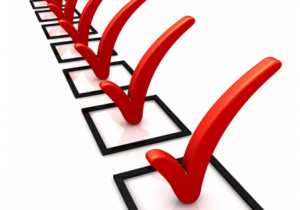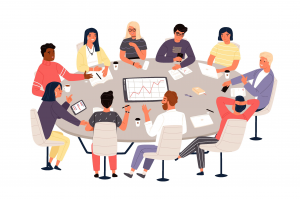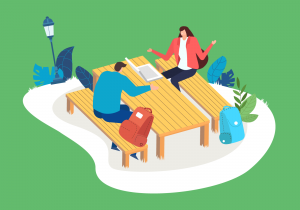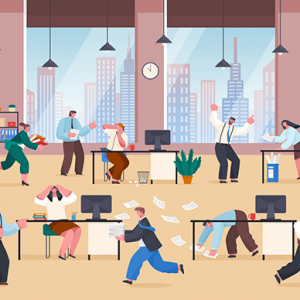When A Leader Leaves The Organization
 We’ve probably all experienced the stress of a key leader or team member leaving their position, whether it’s a sudden departure or an impending retirement. It can cause uncertainty within an organization and can really rock the boat. Team members have questions about the future and how changes will affect them and their jobs. And there’s the added challenge of finding the right person to fill a vacant position with the required skills and expertise. What if there was a way to make this type of situation easier to handle? It’s called succession planning and it’s a vital, yet often overlooked, tool in helping your organization run smoothly.
We’ve probably all experienced the stress of a key leader or team member leaving their position, whether it’s a sudden departure or an impending retirement. It can cause uncertainty within an organization and can really rock the boat. Team members have questions about the future and how changes will affect them and their jobs. And there’s the added challenge of finding the right person to fill a vacant position with the required skills and expertise. What if there was a way to make this type of situation easier to handle? It’s called succession planning and it’s a vital, yet often overlooked, tool in helping your organization run smoothly.
What is succession planning? It’s the process of identifying critical positions within your organization and developing an action plan for team members to be ready to fill those positions should they become available. Think of it as an insurance plan that you have the right people in the right jobs when you need them. However, it’s not a one and done kind of task. An effective succession plan should be reevaluated and updated each year or when changes dictate.
There are so many benefits to succession planning, yet many organizations don’t take the time and care required to build an effective plan. However, putting in the effort reaps so many rewards, including the following:
- Helps your organization plan for the future: Change can happen fast and so many organizations are caught off guard when a key team member leaves. With succession planning, leaders continually think about how certain events can affect their department as a whole and it makes them more resilient in the face of unexpected events.
- Assists with knowledge transfer: When a long-time employee retires or leaves for another position, they take their knowledge with them. Succession planning helps to stop this drain on organizations by having future candidates who are ready to take the reins. It opens up the opportunity for mentoring, coaching and education on what it takes to be successful in a future role.
- Promotes training and development: Once your company has identified team members that are interested in moving into senior positions, you can identify any competency gaps and begin preparing them for their eventual roles. This may come in the form of coaching, mentoring, job shadowing or a gradual increase in more advanced responsibilities. Some positions may require certifications or continuing education.
- Helps with long-term talent planning and employee retention: Succession planning improves retention of your top employees by offering them clear opportunities for growth. By planning longer-term, organizations can reduce their reliance on external recruitment and have a pool of experienced employees in-house.
Changes in your team are inevitable. You may not always be able to predict an employee’s departure, but with effective succession planning, you can help achieve continuity and lessen the impact on your organization. Does your department have a succession plan in place? If so, when’s the last time it was updated? Leah M Joppy and Associates can work with your organization to develop an effective succession plan or review your current plan and make suggestions for improvements. We get to know your department and unique needs and walk you through every step of the process (you’ll see a few examples in our next article).
Succession plans are easy to let fall through the cracks, but don’t be caught off-guard if you lose a key member of your team. Contact us at 301-670-0051 or email us at leah@lmja.com to learn more.
Tips For Successful Succession Planning
 An aging workforce, shrinking talent pool and intensified competition for the right team members put so many organizations under increasing pressure. The benefits of succession planning have never been more apparent, yet few organizations have a plan at all, even for senior leadership positions. With the right plan in place, you can rest a little easier knowing that you’re prepared for inevitable personnel changes and won’t be caught off guard.
An aging workforce, shrinking talent pool and intensified competition for the right team members put so many organizations under increasing pressure. The benefits of succession planning have never been more apparent, yet few organizations have a plan at all, even for senior leadership positions. With the right plan in place, you can rest a little easier knowing that you’re prepared for inevitable personnel changes and won’t be caught off guard.
How can your organization get started with succession planning? Here are a few tips for kickstarting an effective plan:
- Identify potential roles to plan for: The first step is to identify the critical positions within your organization. Sometimes these positions are leadership roles or they’re mid-level. You should identify roles where the operation, strategy and decision-making of your organization would be dramatically affected if they were to be suddenly empty.
- Define succession criteria: Criteria includes the skillset, experience and training required for potential successors. Does the role need someone with specific technical expertise? Perhaps you need successors with strong leadership skills or the ability and willingness to develop those skills? These criteria act as your benchmark for evaluating the readiness of candidates to fill your roles.
- Pinpoint succession candidates: Think about which team members could potentially step into the identified positions. Ask yourself: If we were to hire for a position internally, who could possibly step into the role? You want to carefully evaluate employees’ performance, potential and readiness to take on higher-level responsibilities.
- Step up professional development efforts: Now that you’ve identified your talent pool, it’s time to focus on the training to get them to where they need to be. This typically involves creating a personalized development plan for potential successors to enhance their skills and knowledge required for future leadership roles.
- Develop a knowledge transfer process: This opens up opportunities for mentoring and coaching for successors and ensures that specialized knowledge and skills don’t leave when a team member walks out the door. Experienced leaders can guide and support successors in their professional growth, while sharing their knowledge and experiences.
- Review and monitor your plan: Regularly monitoring the progress of the succession plan is vital to its success. This typically involves tracking the development and performance of potential successors, evaluating their readiness for advancement and then making any adjustments to the plan.
- Continually update your plan over time: As we mentioned before, succession planning is not a one and done process. It requires review at least yearly to analyze any areas that need adjustment.
Most of all, it’s vital to be proactive with a plan! Sometimes, you’ll know well in advance if a hard-to-replace team member is going to leave. But other times, you’ll be caught off-guard by a sudden employee departure. That’s why you need a plan now. Leah M Joppy and Associates can help you every step of the way with your succession planning. Drafting a succession plan can feel like a daunting task, but with the right coach working with you through the process, it doesn’t have to be. And the result means you won’t have to deal with the upheaval that can come with personnel changes.
Ready to learn more? Call us at 301-670-0051 or email us at leah@lmja.com.
Overworked? Burned Out?
 Last month, the website FinanceBuzz released a study of the most overworked cities in the U.S. In the study, researchers looked at metrics such as:
Last month, the website FinanceBuzz released a study of the most overworked cities in the U.S. In the study, researchers looked at metrics such as:
- average number of hours worked per week,
- average commute time and
- percentage of workers who work 50+ weeks per year.
And the winner of the most overworked city is: Washington, D.C. If you’d like to take a closer look at the study and the methodology behind it, here’s a link.
We probably don’t need a study to tell us that the Washington region suffers from a severe case of “overwork.” So many of us feel like we’re doing the work of two or three people and juggling it all can seem like an impossible task. But very few people can keep going at a frantic pace and not experience some symptoms of overwork. A few of the most common symptoms are outlined below:
- Increased stress levels and physical symptoms: People may notice fatigue, headaches or gastrointestinal issues.
- Difficulty sleeping: Sleep behaviors may be disturbed, reduced or increased.
- Decreased productivity: When workloads increase, employees may struggle to keep up, resulting in missed deadlines and making more mistakes.
- Procrastination: Some employees may resort to avoidance and procrastination as a way to deal with overwhelm.
- Increased absenteeism: Increased workloads can cause employees to take more sick leave to deal with stress.
- Decreased job satisfaction: When workers feel overwhelmed and overworked, they may lose motivation and become disillusioned with their jobs. This can often lead to higher rates of turnover, particularly in a competitive job market.
Although they’re similar and often used interchangeably, overwork and burnout are not the same. Overwork refers to the act of working too hard or too much. The term “burnout” was first used in 1974 by German-American psychologist Herbert Freudenberger, who defined it as “the physical or mental collapse caused by overwork or stress.” The key is to identify any symptoms of overwork you may be experiencing (the earlier, the better!), so you can prevent burnout.
Prolonged periods of overwork can begin to take a toll on our mental and physical health, as well as personal relationships. When we overwork and fail to prioritize our own needs and self-care, we don’t give our brain or body what it needs to recuperate. In our next article, we’ll take a look at a few ways to handle increasing workloads. If you notice that your workload is starting to negatively impact your life, working with a coach, like Leah M Joppy and Associates, can be incredibly beneficial. We can help you achieve the balance you’ve been striving for, both professionally and personally, before your day-to-day stressors lead to burnout. Contact us at 301-670-0051 or email us at leah@lmja.com to learn more.
How Your Organization Can Attract Millennial and Gen Z Employees
 Finding the right employees can be tough, but keeping them can be even tougher. In 2022, 46.2 million workers voluntarily quit their jobs, becoming what’s now known as The Great Resignation. And it’s estimated that 46% of the American workforce wants to switch jobs in 2023, making employee retention a key concern. Now more than ever, organizations need to come up with fresh approaches to retain their current workers. This is especially true of Millennial and Gen Z employees.
Finding the right employees can be tough, but keeping them can be even tougher. In 2022, 46.2 million workers voluntarily quit their jobs, becoming what’s now known as The Great Resignation. And it’s estimated that 46% of the American workforce wants to switch jobs in 2023, making employee retention a key concern. Now more than ever, organizations need to come up with fresh approaches to retain their current workers. This is especially true of Millennial and Gen Z employees.
Let’s take a look at these two groups. Millennials were born between 1981 and 1996 while Gen Z refers to those born between 1997 and 2012. Between the two of them, they make up almost 50% of the workforce today. Gen-Z alone is expected to form 27% of the workforce in the next two years. Both Millennials and Gen Z have a reputation for job hopping and lacking “company loyalty”. However, if organizations make an effort to understand the needs and wants of these two groups and grant them the opportunities to grow and thrive, this reputation isn’t always true.
Your recruitment strategies may have helped you acquire a new crop of employees, but if they are not rewarded appropriately with career opportunities, development and other incentives, there is a larger risk of them leaving. What are some of the top things that Millennials and Gen Z look for in an employer? Here’s a glimpse at 5 of them:
- Offer them flexibility and work-life balance: Some may bristle at the work-from-home or hybrid model, but it’s here to stay. Gen Z and millennial employees value flexible work places and working practices and are interested in jobs that will be adaptable to their lifestyle.
- Place an emphasis on their well-being: Millennials and Gen Z want to work for organizations who take care of them and their health as individuals. And it’s not just about physical well-being, but mental health as well.
- Provide them with strong, transparent managers: Management really matters! Grant these two groups more autonomy and less micromanagement, communicate openly and seek their input and ideas.
- Invest in their growth: Gallup found that 87% of millennials rate development opportunities as important to them in a job and LinkedIn found that 76% of Gen Z say learning is key to their success.
- Provide them with mentors: A study by CNBC found that 90% of employees who have assigned mentors say they are happy in their jobs. And greater employee satisfaction leads to better retention!
In today’s multigenerational workforce, organizations can no longer rely on a one-size-fits-all approach to retaining and motivating employees. The most successful organizations truly understand employees’ expectations in the workplace. Leah M Joppy and Associates can work with your organization to build an effective employee retention strategy and help you create programs, systems and communication styles that they meet different employee needs, whatever generation they are from.
Ready to learn more? Call us at 301-670-0051 or email us at leah@lmja.com.
Top Five Suggestions For Leading An Effective Team
 Today’s leaders often feel like they’re in a never-ending game of tug-of-war. Between dealing with day-to-day obstacles, managing projects and team members, it can be overwhelming. The “people” component is certainly the most integral to an organization and can prove to be the most challenging. Building a high-performing team is more than just putting together a group of talented people with the right skills. It requires careful development of each member’s unique talents and characteristics.
Today’s leaders often feel like they’re in a never-ending game of tug-of-war. Between dealing with day-to-day obstacles, managing projects and team members, it can be overwhelming. The “people” component is certainly the most integral to an organization and can prove to be the most challenging. Building a high-performing team is more than just putting together a group of talented people with the right skills. It requires careful development of each member’s unique talents and characteristics.
There is so much strong leaders can do to build effective, high-performing teams. Here’s a look at the top five suggestions. But remember, it’s a marathon and not a sprint. It’s a continuous process and not a “one and done” task:
- Establish meaning and purpose: It’s a leader’s job to help employees and teams find meaning in their work. To increase productivity and motivation, have discussions about the “why” of your team’s tasks. Team members who are passionate and motivated help drive team effectiveness because they understand how their work contributes to the organization’s overall objectives.
- Define roles and responsibilities: Leaders must ensure that everyone on the team knows exactly what is expected of them. It reduces confusion and conflict and allows teams to work more efficiently. Role clarity also enables leaders to hold team members accountable for their performance and identify areas where someone may struggle.
- Communicate effectively: Effective communication and effective leadership are definitely intertwined and it can make, or break, a team. As a leader, it’s vital to: practice active listening and allow people to give constructive feedback without fear of repercussions; ask questions and don’t be defensive; have an open-door policy; follow through with actions.
- Focus on building relationships: Building relationships helps to create (or reinforce) an organization’s values and culture. Once leaders and team members genuinely trust and respect each other, regular, open dialogue about individual and team performance increases team effectiveness.
- Provide productive, specific and timely feedback: Feedback is critical to improving performance, but how you deliver it can make a big difference. Productive feedback enables team members to see their successes and missteps and grow from the experience.
To build high-performing teams, organizations must cultivate high-performing leaders. People skills typically account for 80 percent of success in a leadership role. Yet many people are promoted into leadership because of their technical capabilities, without mastering the skills of managing and motivating others. Without these basic skills, leaders at every level can struggle with building high-performing teams. Leah M Joppy and Associates understands the challenges that accompany leadership roles and knows the proven techniques for building strong leaders who can build motivated, productive teams.
Ready to learn more? Call us at 301-670-0051 or email us at leah@lmja.com.
Strengthsfinder Assessment Tool
 What management challenges has your organization experienced over the past few years? How have issues changed or developed over the last 12 or 6 months? As more and more employees are returning to the office, you’re probably dealing with a fresh set of challenges and we outlined just a few in our previous article. Last year was a period of office ‘reentry’ and now it’s time to figure out how to juggle in-person team members, hybrid and remote workers while not sacrificing performance. It’s a lot to handle and how do you even begin?
What management challenges has your organization experienced over the past few years? How have issues changed or developed over the last 12 or 6 months? As more and more employees are returning to the office, you’re probably dealing with a fresh set of challenges and we outlined just a few in our previous article. Last year was a period of office ‘reentry’ and now it’s time to figure out how to juggle in-person team members, hybrid and remote workers while not sacrificing performance. It’s a lot to handle and how do you even begin?
Let’s start with a few of the basics. We’ve outlined a few “dos and don’ts” below. Maybe you’re already using some of them or perhaps they’re a good reminder of where you need to improve:
- Do set immediate and clear expectations – and make sure everyone knows what they are!
- Do schedule regular team meetings and make them a priority (no regular cancellations, please). It’s an effective way to acquaint (or reacquaint) yourself with your team’s work and communication style and find areas for improvement.
- Do engage directly with employees as often as possible.
- Don’t just have a communication strategy in place – document it and share it! Everyone needs to be on the same page.
- Don’t just encourage feedback, make it possible. And listen to it!
- Don’t micromanage and make employees feel like they’re not trusted.
- Do have an open-door policy and set aside time for one-on-one conversations.
- Do have regular team building activities that enable in-person, hybrid and remote team members to get to know each other in a fun, casual setting.
- Don’t forget about mental health. Make sure you’re communicating benefits that your organization provides to employees. Listening to team members and working with them to address concerns is one of the most important things you can do.
A proactive approach and implementing improvements not only keeps your organization moving forward, but also shows team members, whether they’re in the office, remote or hybrid, that you’re engaged in their wellbeing. Fortunately, you don’t have to handle it alone. Working with a coach like Leah M Joppy and Associates and utilizing our Strengthsfinder assessment tool is an ideal way to get started. We outlined the benefits of Strengthsfinder in our previous article. The data it provides goes a long way towards leveraging team members’ strengths, addressing team conflicts and improving communication. Want to learn more? Call us at 301-670-0051 or email us at leah@lmja.com.
Challenges In The Workplace – How A Coach Can Help
 Over the past few years, we’ve all had to adjust to the virtual workplace and the challenges that came with it – from being interrupted on Zoom calls from a crying toddler to missing out on casual chit chat with your colleagues as you grab a morning coffee. Or perhaps you were hired during the pandemic and don’t really feel connected to your new team. Now that people are slowly returning to the workplace, many organizations are dealing with a whole new set of challenges. We’ve broken down the top 3 below:
Over the past few years, we’ve all had to adjust to the virtual workplace and the challenges that came with it – from being interrupted on Zoom calls from a crying toddler to missing out on casual chit chat with your colleagues as you grab a morning coffee. Or perhaps you were hired during the pandemic and don’t really feel connected to your new team. Now that people are slowly returning to the workplace, many organizations are dealing with a whole new set of challenges. We’ve broken down the top 3 below:
- Office Etiquette: Let’s face it – we all developed some interesting habits while working at home, whether it’s living in pajamas, pacing around the house while on a phone call or leaving a pile of dirty dishes in the sink to deal with later. Clearly, this isn’t going to fly in a professional environment. Management needs to set guidelines when it comes to office etiquette and clearly communicate areas such as: respecting team members’ personal space, dress code, keeping workspaces clean and being mindful of voice level. Patience needs to be practiced as everyone readjusts to office life. It’s not fun, but managers must be ready to have conversations when/if issues arise.
- Communication: While some team members are returning to the office, many may be on a hybrid work schedule and others may continue working remotely. This can make communication challenging for even the most seasoned managers. Effective communication requires clarity, consistency and careful listening.
- Team Building: Returning to the office can be particularly difficult for employees who were on-boarded during the pandemic. The existing team may wonder, “Who are the new people? What role will they play within the team? What knowledge and skills do they bring to the group? Will they be a team player?” The new employees may feel like they’re truly part of the team and may not feel comfortable speaking up or asking questions.
How Working With a Coach Can Help
It’s easy to say “communicate more with your employees” or “set clear expectations”, but how do you get started when you’re already feeling overwhelmed? That’s where working with a coaching team like Leah M Joppy and Associates can help. Our popular Strengthsfinder assessment tool has helped organizations and team members learn so much about their core competencies, how to use them to their advantage and where to make improvements.
Participants who have taken this assessment develop a clear understanding of how to use their strengths to support and effectively communicate with team members, as well as work together to support agency mission and goals. This tool also identifies complementary strengths that enable team members to support each other in areas where they may not be as efficient. In addition, this self-awareness insight enables participants to:
- Better manage team and customer conflict
- Leverage individual strengths and communication styles to build cross-agency collaborative partnerships
- Maximize creativity
- Increase performance
Imagine what your organization could do armed with this kind of data! Contact Leah M Joppy and Associates at 301-670-0051 or email us at leah@lmja.com to learn more and get started.
Drivers Of Engagement
 According to recent research by Gallup, the percentage of engaged workers in the U.S. dropped in 2021 for the first time in a decade. The trend continued into 2022 with only 32% of full and part-time employees engaged and 17% actively disengaged. These lower levels of engagement have certainly fueled “The Great Resignation” with workers looking for more meaningful work, greater flexibility and increased work-life balance. Employee engagement is a topic that organizations can no longer push under the rug, but need to examine more closely and determine what’s working and what isn’t.
According to recent research by Gallup, the percentage of engaged workers in the U.S. dropped in 2021 for the first time in a decade. The trend continued into 2022 with only 32% of full and part-time employees engaged and 17% actively disengaged. These lower levels of engagement have certainly fueled “The Great Resignation” with workers looking for more meaningful work, greater flexibility and increased work-life balance. Employee engagement is a topic that organizations can no longer push under the rug, but need to examine more closely and determine what’s working and what isn’t.
Let’s start by defining employee engagement. In a nutshell, it’s the measure of how involved and enthusiastic your team members are about coming to work every day. It’s their emotional commitment to your organization, including the mission, core values and vision. Here’s what engaged employees look like:
- They’re proud of where they work and typically happy with their job, manager and company culture
- They intend to stay with an organization
- They would recommend their workplace to others
- They’re actively interested in their job and support and encourage fellow team members
Now that we know what employee engagement is, what are some of the top drivers of engagement? Most of us would say compensation, and while it certainly plays a role, it’s not the most important factor. Here’s a look at the top 5:
- Strong leadership: One of the biggest discoveries from Gallup’s employee engagement research is that managers or team leaders alone account for 70% of the variance in team engagement. That’s quite a percentage! Strong leadership truly matters.
- Caring organizational culture: Like strong leadership, an organization’s culture plays a prominent role in how team members feel about their job. Helping team members feel that the work they’re doing is essential for the success of the organization will create a positive employee experience. A culture that emphasizes work/life balance and employee wellness (just to name a few), goes a long way in boosting engagement.
- Meaningful work: Everyone wants to feel like their work means something and has a purpose. It boosts enthusiasm, productivity and connection. It’s also a major driver of employee retention.
- Professional growth opportunities: Research shows that employees are much more likely to be engaged in jobs with organizations that make learning and professional development part of their culture. Fostering personal growth opportunities helps employees achieve their personal goals and leads to greater satisfaction and dedication.
- Regular feedback and recognition: Having a consistent system of feedback within an organization is one of the best ways to build strong communication. In organizations that emphasize feedback as an important part of their culture, employees receive regular, helpful feedback from direct supervisors and are encouraged to provide meaningful feedback to co-workers and leadership. It’s truly a two-way street.
As you read this list, think about your organization. Do you feel like you’re hitting the mark on all five? Or maybe you notice weak spots and see room for improvement. Working with a coach, like Leah M Joppy and Associates, can help. We collaborate with you to look at areas where engagement is low, establish where improvements can be made and come up creative solutions that will increase team members’ engagement and morale.
There’s no better time than the present to get started! Team members want more than a good paycheck and a warm, fuzzy feeling to feel invested in their work and contribute their best to an organization. Call us at 301-670-0051 or email us at leah@lmja.com
Drivers Of Disengagement
 Are there any leaders out there who haven’t encountered employee disengagement at one point or another? If you’re in a management position, you can probably recall at least a few instances. If not, you’re either extremely fortunate or you may not know the signs to watch out for. Disengagement can rear its head in a variety of forms. For example, team members can feel out of the loop in terms of communication and resources or they may be struggling with work/life balance. They may also feel discouraged by a lack of company culture or difficulty collaborating with team members.
Are there any leaders out there who haven’t encountered employee disengagement at one point or another? If you’re in a management position, you can probably recall at least a few instances. If not, you’re either extremely fortunate or you may not know the signs to watch out for. Disengagement can rear its head in a variety of forms. For example, team members can feel out of the loop in terms of communication and resources or they may be struggling with work/life balance. They may also feel discouraged by a lack of company culture or difficulty collaborating with team members.
In our last article, we looked at the top 5 drivers of employee engagement. But what are some of the red flags to watch out for when it comes to employee disengagement? Here are a few examples of an unengaged team member:
- Withdrawal from any non-necessary activities or conversations
- Poor communication and lack of participation
- Breaks from routine (i.e.: a typically vocal person no longer speaks up in meetings, a punctual person is chronically late or misses deadlines)
- Apathetic approach to meetings, projects, communication, etc.
- Rudeness and curtness with coworkers and clients
What’s the common denominator? It’s a change in behavior that lasts for a prolonged period of time.
With all of the challenges leaders are facing in today’s workplace, problems with disengaged employees can sneak up quickly and snowball into major issues. That’s where Leah M Joppy and Associates can help. We can get to the root causes of WHY team members are feeling disengaged and work with you to come up with ideas to address these problems quickly.
When it comes to employee disengagement, it’s so important to look for solutions right away, rather than wait until productivity declines and turnover increases. Call us at 301-670-0051 or email us at leah@lmja.com and let’s start tackling any disengagement issues now!
Burnout For Organizations
 Burnout. It’s something no one wants to feel and it’s an issue that no organization wants to experience. But increased levels of employee burnout are becoming more common across every industry and not just the ones we think of most, like healthcare and teaching. Many organizations think of burnout as an “individual problem,” solvable by an employee just taking the afternoon off or practicing some breathing techniques. Wrong! It affects your organization at every level and has a negative impact by decreasing morale and increasing turnover.
Burnout. It’s something no one wants to feel and it’s an issue that no organization wants to experience. But increased levels of employee burnout are becoming more common across every industry and not just the ones we think of most, like healthcare and teaching. Many organizations think of burnout as an “individual problem,” solvable by an employee just taking the afternoon off or practicing some breathing techniques. Wrong! It affects your organization at every level and has a negative impact by decreasing morale and increasing turnover.
According to the World Health Organization, burnout is a syndrome resulting from workplace stress that has not been successfully managed. It’s characterized by three dimensions: feelings of energy depletion or exhaustion; increased mental distance from one’s job or feelings or negativism or cynicism related to one’s job; and reduced professional efficacy (World Health Organization, 2019). It’s incredibly costly for organizations. Consider these statistics: according to the American Psychological Association’s 2021 Work and Well-being Survey of nearly 1,500 U.S. workers, 79% of employees had experienced work-related stress in the month before the survey. Nearly 3 in 5 employees reported negative impacts of work-related stress, including lack of interest, motivation, or energy (26%) and lack of effort at work (19%). Meanwhile, 36% reported cognitive weariness, 32% reported emotional exhaustion, and 44% reported physical fatigue—a 38% increase since 2019.
It’s important to train managers to recognize the signs of burnout in team members and have a comprehensive plan in place to address underlying issues. Symptoms of burnout include:
- Decreased engagement and enthusiasm in work
- Increased absenteeism
- Decreased productivity
- Isolation
- Higher sensitivity to feedback
Employee burnout is one the most pressing challenges that organizations face today. Leaders need to know the prominent signs (as we outlined above) and how to work with team members on solutions that have a lasting impact. It’s no small task, but in the end, it’s a win-win for everyone. Leah M Joppy and Associates is ready to help your organization face any workforce burnout issues head-on before they become major problems. Call us at 301-670-0051 or email leah@lmja.com and let’s discuss your needs.